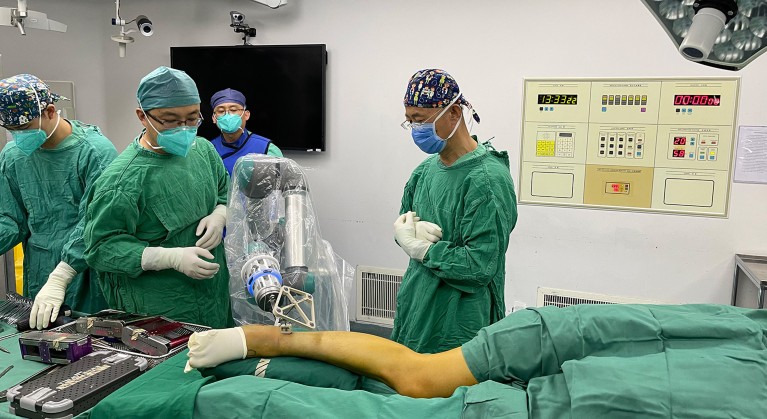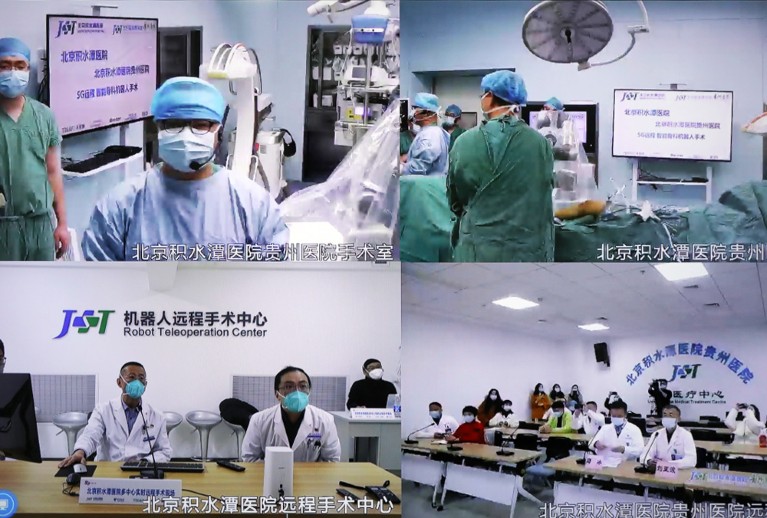The human skeletal structure is notoriously difficult to repair. Surgical treatments include inserting screws and plates, and replacing joints with artificial alternatives. But such procedures are physically demanding and require high surgical precision. The first ‘smart’ orthopedic ward in China is set to change this.
The pioneering ward was established in Beijing Jishuitan Hospital, under the leadership of Xieyuan Jiang, head of the hospital, and Junqiang Wang, its chief orthopedic surgeon. Their aim is to achieve better patient outcomes by using robotic assistance for complex bone surgeries.
A robot assistant
Surgeries to correct pelvic injuries are some of the most challenging operations an orthopedic surgeon can face, due to the complicated anatomy of the pelvis and the risk of incorrectly positioning screws1.

The TiRobot in action during a surgical procedure at Beijing Jishuitan Hospital, China.
To address this, Jiang and a team of experts on AI and biomedical engineering adapted an existing orthopedic surgery robotic system, called TiRobot, made by Beijing Tianzhihang Medical Technology Co., LTD. The team developed new and improved algorithms to apply the robot to treat pelvic fractures.
TiRobot was designed under the leadership of the Orthopedics clinical team at Beijing Jishuitan Hospital, and can analyse medical images of bones, such as those generated by CT scans, and calculate an optimal location for screws to be inserted, as well as an appropriate degree of force to apply2. In this way a detailed surgical protocol for the TiRobot’s arm can be entered into the system.
In a 2023 study1, Wang and colleagues reviewed 128 cases of posterior pelvic ring injury treated by placing screws through the skin into the back of the pelvis between the sacrum and the ilium in a process called ‘percutaneous sacroiliac screw fixation’. These surgeries were performed by the TiRobot and freehand by surgeons between 2016 and 2020. Fluoroscopy-based imaging was required to confirm screw placement in both freehand and robotic cases.
The researchers found damage from incorrect screw positioning in 5 out of the 62 surgeries performed manually by surgeons, but no cases of incorrect positioning in any of the surgeries performed by robots. The TiRobot-assisted operations also meant less time spent on producing radiographs generated by the fluoroscopy technique, meaning less harmful exposure to radiation for both patients and clinicians.
Advanced applications
Wang’s team have also found that the TiRobot could also aid in cases of severe injuries with bad breaks and complicated surgeries.

A screenshot of the remote segment interface for the telerobotic surgery system developed at Beijing Jishuitan Hospital.
They have developed a protocol of sequential minimally invasive surgeries for multiple pelvic fractures. Under this protocol, the TiRobot first helps fix the pelvic ring, which comprises the sacrum, the two hip bones and the three joints connecting them together. This is done within six hours following injury to maintain circulation within the bone. The robot then uses a minimally invasive technique to repair other fractures within 24 hours.
Wang says this treatment protocol treatment has the potential to reduce the number of required surgeries along with the admission rate to intensive care units.
Wang’s team is now focusing on further developing a robotic system for remote diagnosis and treatment3, which could facilitate minimally invasive operations across China, particularly in regions where medical resources are poor.
“Through large-scale and routine application, we will collect more evidence on robotic surgery, which we hope will contribute to a truly smart and precise orthopedic therapy,” says Wang.


